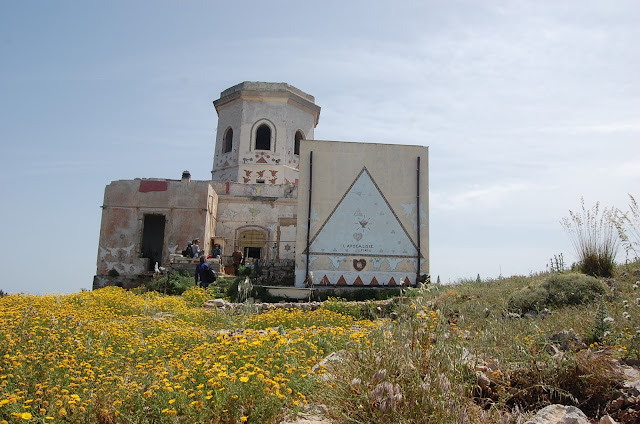picture by Raija Kalioinen (may 2015)
In 1996 Isravele - the name after which the worker has renamed himself - decides to leave his family and home, in the Zen district in Palermo in order to retire to Mount Gallo, occupying an abandoned military lighthouse. He recovered the old block and turns it into a personal sanctuary: he built a small altar inside and decorated walls, floors, ceilings with geometric and abstract figures, perfectly harmonious and logical, and mystical ideas. He used paints, concrete, sea pebbles, stones, newspaper clippings and devotional images in a continuous work in progress. Stand out above all the decorations in the hexagonal tower of the building and on the exterior walls. The hermit also worked on the landscape and on the path leading to the shrine, with scattered traces, creating a "holy way" similar to a initiation path.
Facing the Mediterranean, Capo Gallo is a natural area, since 2001 a natural reserve, north of Palermo, on the Italian island Sicily. Because of the proximity of the sea, the area has marine facilities, such as a lighthouse and an elevated building as in above picture, that once was a military lookout and semaphore.
Life and works
More than a decade ago this building became the home of a hermit who is known as Isravele, the name he has adopted.
Not much is known about his life. He was born in the early 1950's, had a job as a mason, worked in Palermo and was a deeply religious man.
He told a reporter who visited him, that in 1985 he had a dream that changed his life, convinced as he became by that dream that he had to be a prophet with the mission to save people's souls.
After that dream he continued his job, adressing his colleagues with religious insights, and then, in 1997 he left wife and children, to restart his life as a hermit, first living in a cave in the seaside rocks in the Capo Gallo natural area. Later he squatted the no longer used and abandoned semaphore building in the same area.
In the course of the years Isravele has decorated this building in such a way, that it has become kind of a sanctuary.
He signposted the road uphill to this sanctuary with small decorations, painted or made from pebbles, and mostly depicting a heart, suggesting this path is a Via Santa.
The interior of the building has been lavishly decorated. The walls are geometrically divided into compartments, each of which is decorated with a large item, such as a portrait or a mosaic representation, surrounded by smaller items like stars, crosses or other signs.
To make his decorations Isravele uses small pebbles, he collects on the beaches. He makes great use of the hexagram and other religious symbols.
It is noteworthy that there are no religious texts and inscriptions on the walls, except one above a clock reading ALLELUIAMEN. The appearance of the interior is rather quite, orderly and understated.
Outside, however, there is an inscripted text about the End of Times, the return of Gods kingdom, which will be accompanied by great destructions.
Isravele is a shy person. A visitor who met him in 2010, has described him as a good looking man with dark, greying hair and a bushy greying beard, adding: "He's articulate, and enthusiastic when talking about God".
Isravele, however, is not eager at all to meet visitors, rather avoids them and he doesn't appear in the video's below. One may wonder if he agreed that the videos were recorded.
However, if a visit is pre-arranged by people or organisations he trusts, Isravele will welcome (small) groups of interested people.
outsider-environments.blogspot.com
lesgrigrisdesophie.blogspot.com
lesgrigrisdesophie.blogspot.com
www.costruttoridibabele.net
www.outsidart.com
www.francescoinviaggio.it
www.imgrum.net/tag/Isravele
www.francescoinviaggio.it
www.imgrum.net/tag/Isravele















No comments:
Post a Comment